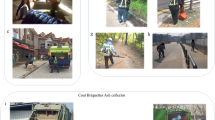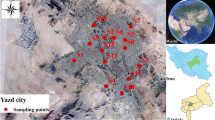Abstract
Although every year, thousands of people die from asbestos-related diseases, many people disregard things that are past. Meanwhile, a lot of people, in particular, in many Asia countries that have no guideline values for waterborne asbestos are currently in a fever of anxiety about the possibility of its health hazards. This study focused on a grasping the actual situation of asbestos in household tap water. An intensive collection of the tract drinking-water was conducted in Iksan, Korea (at six homes), and Fukuoka, Japan (at nine homes). After pretreatment, both morphological observation and elemental analysis were simultaneously carried out using a scanning electron microscopy (SEM) with an energy dispersive X-ray spectrometer (EDX). The concentrations of waterborne asbestos fiber varied from place to place in both local cities. Their average concentrations at all sites in Iksan and Fukuoka were 213.3 and 181.1 f/L, respectively. Although the measured values in this study were the sum of chrysotile, amosite, and crocidolite fibers with a high risk of cancer, they were found to be consistently below the MCL (the Maximum Contaminant Level recommended by the U.S. toxicological profile for Asbestos). A significant link was found between open water supply channels and waterborne asbestos. The backward wind trajectory projections indicated that the present water sampling sites might be affected by the airborne asbestos fiber in the upwind atmosphere.








Similar content being viewed by others
References
Bull, S. (2007). Asbestos general information. Health Protection Agency of U. K. Ver.1, pp. 1–15.
Chen, S., Pace, M. (2012). Malignant Pleural Mesothelioma. American Journal of Health-System Pharmacy. http://www.medscape.com/viewarticle/759119_2.
Guidelines for drinking-water quality, 2nd ed. Vol. 2 (1996) World Health Organization.
Hodgson, J. T., & Darton, A. (2000). The quantitative risks of mesothelioma and lung cancer in relation to asbestos exposure. Annals of Occupational Hygiene, 44(8), 565–601.
Hosny, G., & Akel, M. (2006). Assessment of asbestos in drinking water in Alexandria, Egypt. The Journal of the Egyptian Public Health Association, 81, 184–195.
Jack, F., Nath, K. (1999). Policy statement for removal and disposal of asbestos cement pipe in the city of Mesa, Arizona, pp 1–4.
Jajuminbo (2010) The Saemangeum seawall project. http://jajuminbo.net/subread.html?uid=6083§ion=sc18. Accessed 12 Oct 2016
Kanarek, M. S., Conforti, P. M., Jackson, L. A., Cooper, R. C., & Murchio, J. C. (1980). Asbestos in drinking water and cancer incidence in the San Francisco Bay area. American Journal of Epidemiology, 112(1), 54–72.
Ma, C. J., Kang, G. U., & Kim, K. H. (2010). High loading for air pollution in the Byunsan Peninsula of Korea by an interplay of the Saemangeum project and winter monsoon. Asian Journal of Atmospheric Environment, 6(3), 234–243.
Marfels, H., Spurny, K., Boose, C., Schoermann, J., Opiela, H., Althaus, W., & Weiss, G. (1984). Measurements of fibrous dusts in ambient air of the Federal Republic of Germany (1), measurements in the vicinity of an industrial source. Staub-Reinhalt Luft, 44, 259–263.
Millette, J. R., Craun, G. F., Stober, J. A., Kraemer, D. F., Tousignant, H. G., Hidalgo, E., Duboise, R. L., & Benedict, J. (1983). Epidemiology study of the use of asbestos cement pipe for the distribution of drinking water in Escambia County, Florida. Environmental Health Perspectives, 53, 91–98.
NIOSH. (1994). Method 9002: Asbestos (Bulk) by PLM, in Eller PM, Cassinelli, ME, eds. NIOSH Manual of Analytical Methods 4th ed., Cincinnati OH: U.S. Department of Health and Human Services, Public Health Services, Centers for Disease Control and Prevention, National Institute for Occupational Safety and Health, DHHS (NIOSH) Publication No.94-113.
Saitoh, K., Takizawa, Y., Muto, H., & Hirano, K. (1992). Concentration and form of asbestos fibers in tap drinking water. Japanese Journal of Hygiene, 47, 851–860.
Schreier, H. (1989). Asbestos in the natural environment. Studies in Environmental Science, 37, 45–67.
Stein, A. F., Draxler, R. R., Rolph, G. D., Stunder, B. J. B., Cohen, M. D., & Ngan, F. (2015). NOAA’s HYSPLIT atmospheric transport and dispersion modeling system. Bulletin of the American Meteorological Society, 96, 2059–2077.
Sugio, F., Fuyushi, N., Yuji, N. Shigeharu, N. (2002) Japanese Situation on Asbestos Issues and BANJAN’s Activities 29(3), pp.42-63. http://park3.wakwak.com/~banjan/main/taisaku/pdf/taisaku-jyoho29-3.pdf.
Takizawa, Y. (1991) The asbestos fiber in tap water. Journal of Clinical and Experimental Medicine. 167 (7), http://anshin-kagaku.news.coocan.jp/sub050801bunsekikekka.html.
The asbestos. (1996). Japan Asbestos Abolition Technology & Information Association pp 1–167.
Toxicological profile for Asbestos (2001) U.S. Department of Health and Human Services, Public Health Service. pp 1–441.
U.S. Department of Health and Human Services (2001) Public Health Statement, Asbestos. https://www.atsdr.cdc.gov/ToxProfiles/tp61-c1-b.pdf. Accessed 12 Oct 2016
Acknowledgements
This paper was supported by Wonkwang Health Science University in 2016. The authors gratefully acknowledge the NOAA Air Resources Laboratory (ARL) for the provision of the HYSPLIT transport and dispersion model and/or READY website (http://www.ready.noaa.gov) used in this publication.
Author information
Authors and Affiliations
Corresponding author
Rights and permissions
About this article
Cite this article
Ma, CJ., Kang, GU. Actual Situation of Asbestos in Tract Drinking-Water in Korean and Japanese Local Cities. Water Air Soil Pollut 228, 50 (2017). https://doi.org/10.1007/s11270-016-3225-0
Received:
Accepted:
Published:
DOI: https://doi.org/10.1007/s11270-016-3225-0




